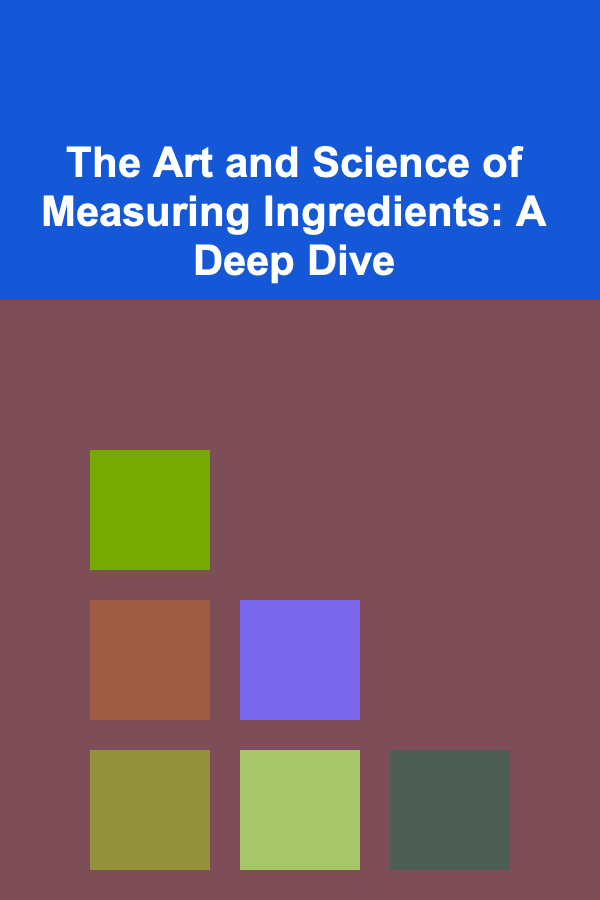
The Art and Science of Measuring Ingredients: A Deep Dive
ebook include PDF & Audio bundle (Micro Guide)
$12.99$8.99
Limited Time Offer! Order within the next:

In the realm of culinary arts, whether you're a seasoned chef or a novice baker, the act of measuring ingredients transcends mere mechanical repetition. It's a foundational skill, a cornerstone upon which the entire edifice of successful cooking is built. Understanding the importance of measuring ingredients is not just about following a recipe; it's about grasping the underlying chemistry, the delicate balance of flavors, and the predictable outcomes that precise measurements guarantee. This article delves deep into the significance of accurate ingredient measurement, exploring its impact on texture, taste, consistency, and the overall success of your culinary endeavors.
The Science Behind the Spoon: Why Measurement Matters
Cooking, at its core, is applied chemistry. Each ingredient interacts with others in specific ways, and the ratios of these ingredients determine the final product's characteristics. Think of baking a cake: the proportion of flour to sugar to fat dictates the cake's structure, sweetness, and moistness. Deviations from these ratios can lead to a flat, dry, or overly sweet result. This is where accurate measurement becomes paramount. It's about controlling the chemical reactions that occur during cooking, ensuring that the desired transformations take place in the expected manner.
Consider the role of leavening agents like baking soda and baking powder. These ingredients release carbon dioxide gas, which creates air pockets within the batter, causing it to rise. The amount of leavening agent used must be precisely measured to ensure sufficient rise without leaving a metallic aftertaste. Too little, and the cake will be dense and heavy; too much, and it will collapse under its own weight and taste unpleasantly of baking soda.
Similarly, the ratio of liquids to dry ingredients significantly impacts the texture of baked goods. Too much liquid can result in a soggy or gummy texture, while too little can lead to a dry and crumbly outcome. Understanding these scientific principles underscores the critical role of accurate measurement in achieving consistent and predictable results.
The Impact on Texture
Texture is a crucial element of culinary enjoyment. It contributes significantly to the overall sensory experience of eating. Measuring ingredients accurately is a primary factor in controlling the texture of your dishes. Here's how:
- Baking: The gluten development in bread and cakes is heavily influenced by the flour-to-liquid ratio. Too much flour creates a tough, dense crumb, while too little results in a weak structure that collapses easily. Yeast activity also depends on precise sugar and liquid measurements.
- Sauces: The thickness and consistency of sauces rely heavily on the accurate measurement of thickening agents like cornstarch, flour, or cream. A slight excess of cornstarch can transform a silky smooth sauce into a gloppy mess.
- Soups: The balance of liquids to solids in soups determines their overall texture. Too much liquid results in a watery soup lacking body, while too little creates a thick, almost stew-like consistency.
- Custards and Creams: These delicate desserts require precise ratios of eggs, milk, and sugar to achieve the desired smooth, creamy texture. Overcooking or incorrect measurements can lead to curdling or a grainy consistency.
The Impact on Flavor
Flavor is, arguably, the most important aspect of any dish. While some ingredients provide the primary flavor profile, others act as enhancers, balancers, or contributors to complexity. Accurate measurement ensures that these flavors are in harmony, creating a cohesive and enjoyable taste experience.
- Salt: A seemingly simple ingredient, salt plays a crucial role in enhancing and balancing flavors. Too little salt can make a dish taste bland, while too much can overwhelm other flavors and render the dish inedible.
- Spices: Spices add depth and complexity to dishes. However, their potency varies greatly. Measuring spices accurately prevents them from overpowering other ingredients or creating an unbalanced flavor profile. A tiny pinch of saffron can transform a dish, but too much can make it bitter.
- Acids: Ingredients like lemon juice, vinegar, and wine add acidity, which brightens flavors and balances richness. Accurate measurement is essential to prevent the dish from becoming overly sour or tart.
- Sweeteners: Sugar, honey, and maple syrup contribute sweetness and moisture. The amount used must be carefully measured to achieve the desired level of sweetness without masking other flavors. In baking, sugar also plays a role in browning and caramelization.
The Impact on Consistency
Consistency refers to the repeatability of results. If you follow a recipe and measure ingredients accurately, you should be able to recreate the same dish with the same taste and texture every time. This is particularly important for professional chefs and bakers who need to maintain consistent quality for their customers.
Imagine a baker who makes a batch of cookies without measuring the ingredients. The first batch might be perfect, but the second batch could be dry, flat, or overly sweet. By measuring ingredients accurately, the baker can ensure that each batch of cookies is consistent in taste, texture, and appearance.
In a restaurant setting, consistency is even more critical. Customers expect the same dish to taste the same every time they order it. This requires chefs to meticulously measure ingredients and follow recipes precisely.
The Tools of the Trade: Measuring Equipment and Techniques
Accurate ingredient measurement relies on the right tools and techniques. Understanding the differences between measuring cups, spoons, and scales, and knowing how to use them properly, is essential for achieving consistent results.
Measuring Cups
Measuring cups come in two main types: liquid and dry. It's crucial to use the correct type of cup for the ingredient you are measuring.
- Liquid Measuring Cups: These are typically made of glass or clear plastic and have a spout for easy pouring. They are designed to measure liquids by volume. To use a liquid measuring cup accurately, place it on a level surface and fill it to the desired line, checking at eye level.
- Dry Measuring Cups: These are typically made of metal or plastic and come in a set of graduated sizes (1 cup, ½ cup, ⅓ cup, ¼ cup). They are designed to measure dry ingredients by volume. To use a dry measuring cup accurately, spoon the ingredient into the cup until it is overflowing, then level it off with a straight-edged utensil like a knife or spatula. Avoid packing the ingredient into the cup, as this will result in an inaccurate measurement.
Measuring Spoons
Measuring spoons are used for measuring small quantities of both liquid and dry ingredients. They typically come in a set of graduated sizes (1 tablespoon, 1 teaspoon, ½ teaspoon, ¼ teaspoon). To use measuring spoons accurately, spoon the ingredient into the spoon until it is overflowing, then level it off with a straight-edged utensil. For liquid ingredients, fill the spoon to the brim.
Kitchen Scales
For the most accurate measurements, a kitchen scale is the preferred tool. Scales measure ingredients by weight, which is a more precise method than measuring by volume. This is because the density of ingredients can vary, meaning that the same volume of different ingredients can have different weights. For example, a cup of flour can weigh differently depending on how tightly it is packed.
To use a kitchen scale, place a bowl or container on the scale and tare it (set it to zero). Then, add the ingredient until the scale reads the desired weight. Kitchen scales are particularly useful for baking, where precise measurements are crucial for success.
Specific Ingredient Measurement Techniques
Beyond using the correct tools, specific ingredients require particular measurement techniques to ensure accuracy:
- Flour: As mentioned earlier, flour should be spooned into the dry measuring cup and leveled off. Avoid scooping the flour directly from the bag, as this will compact it and result in an inaccurate measurement.
- Sugar: Granulated sugar can be spooned or poured into the dry measuring cup and leveled off. Brown sugar, however, should be packed firmly into the cup before leveling.
- Liquids: Always use a liquid measuring cup and measure at eye level. For viscous liquids like honey or molasses, lightly grease the measuring cup to prevent sticking.
- Fats: Solid fats like butter or shortening should be measured using dry measuring cups. Pack the fat firmly into the cup and level it off. For melted butter, use a liquid measuring cup.
- Herbs and Spices: Dried herbs and spices should be measured using measuring spoons. Fresh herbs should be measured after chopping them to the desired size.
The Art of Adaptation: Adjusting for Variations and Preferences
While accurate measurement is essential, it's also important to recognize that recipes are not always foolproof. Factors like altitude, humidity, and oven temperature can affect the outcome of a dish. Furthermore, individual preferences for taste and texture may require adjustments to the original recipe.
Learning to adapt recipes based on these factors is a crucial skill for any cook. Here are some tips for adjusting recipes:
- Altitude: At higher altitudes, water boils at a lower temperature, which can affect the baking process. Baked goods may rise more quickly and dry out faster. To compensate, you may need to reduce the amount of leavening agent, increase the amount of liquid, and lower the oven temperature.
- Humidity: In humid climates, flour tends to absorb more moisture, which can result in a heavier dough or batter. To compensate, you may need to reduce the amount of liquid in the recipe.
- Oven Temperature: Ovens can vary in temperature, even when set to the same setting. Use an oven thermometer to ensure that your oven is accurately calibrated.
- Personal Preferences: Don't be afraid to adjust recipes to suit your own taste preferences. If you prefer a sweeter dish, add a little more sugar. If you like a spicier dish, add more spices. However, make small adjustments at a time and taste as you go.
However, when making adjustments, be mindful of the scientific principles discussed earlier. Changing the ratio of ingredients can significantly impact the texture, flavor, and consistency of the final product. For example, drastically reducing the amount of sugar in a cake recipe can affect its structure and browning.
The Pitfalls of Guesswork: Common Measurement Mistakes to Avoid
Even with the best intentions, it's easy to make mistakes when measuring ingredients. Recognizing and avoiding these common pitfalls is crucial for consistent success in the kitchen.
- Using the Wrong Measuring Tools: As mentioned earlier, using liquid measuring cups for dry ingredients and vice versa can lead to inaccurate measurements.
- Not Leveling Off Dry Ingredients: Failing to level off dry ingredients in measuring cups and spoons can result in significant variations in the amount used.
- Packing Dry Ingredients: Packing dry ingredients like flour or sugar into measuring cups will result in too much of the ingredient being used.
- Not Measuring at Eye Level: When measuring liquids, not checking the measurement at eye level can lead to errors, especially when using liquid measuring cups with curved surfaces.
- Using Inaccurate Measuring Tools: Over time, measuring cups and spoons can become warped or damaged, leading to inaccurate measurements. Replace your measuring tools regularly to ensure accuracy.
- Relying on "Eyeballing": While experienced cooks may develop a sense for approximate measurements, relying solely on "eyeballing" ingredients is not a reliable method for consistent results.
Embracing Precision: The Path to Culinary Mastery
Mastering the art and science of measuring ingredients is an ongoing process. It requires attention to detail, a willingness to learn from mistakes, and a commitment to precision. By understanding the importance of accurate measurement, using the right tools and techniques, and adapting recipes to your own preferences, you can unlock the full potential of your culinary skills and create dishes that are consistently delicious and satisfying.
The ability to accurately measure ingredients is more than just following instructions; it's about understanding the fundamental principles of cooking and developing a deep appreciation for the interplay of flavors and textures. It's the difference between a hit-or-miss culinary experience and a consistently delightful one. So, embrace the precision, invest in the right tools, and watch your culinary creations transform from ordinary to extraordinary.
Beyond the Recipe: The Intuition of the Experienced Cook
While precision is paramount, it's important to acknowledge the role of intuition in cooking. As you gain experience, you'll develop a sense for how ingredients interact and how to adjust recipes based on your own observations and taste preferences. This intuitive understanding complements the foundational skill of accurate measurement. It's about knowing when to deviate from the recipe, when to trust your instincts, and when to let your creativity guide you.
An experienced baker might notice that a dough is too dry and instinctively add a little more liquid, even if the recipe doesn't call for it. A seasoned chef might taste a sauce and realize that it needs a touch more acidity, adding a squeeze of lemon juice to brighten the flavors. These are the subtle adjustments that come with experience and a deep understanding of cooking principles.
However, intuition should always be grounded in a solid understanding of the basics. Accurate measurement provides the framework upon which intuition can flourish. It's about knowing the rules before you break them, understanding the principles before you deviate from them.
The Bottom Line: Consistency, Control, and Culinary Confidence
In conclusion, understanding the importance of measuring ingredients is fundamental to achieving consistent, predictable, and ultimately, successful culinary outcomes. It provides control over texture, flavor, and consistency, allowing you to recreate your favorite dishes with confidence and precision. While intuition and adaptation play a role, they are best informed by a solid foundation in accurate measurement techniques. So, whether you're a seasoned professional or a passionate home cook, embrace the art and science of measurement, and watch your culinary skills flourish.
Reading More From Our Other Websites
- [Gardening 101] How to Plan Your Garden Layout for Maximum Space and Beauty
- [Toy Making Tip 101] From Sketch to Plaything: Designing Custom Toy Patterns for Beginners
- [Personal Investment 101] How to Profit from Deep Learning Without Being a Full-Time Developer
- [Organization Tip 101] How to Prepare Your Antique Collection for Sale
- [Organization Tip 101] How to Organize PDFs and Other Document Types
- [Gardening 101] Organic Garden Pest Control: Safe Solutions for Your Plants
- [Organization Tip 101] How to Create a Relaxation Zone in Your Office
- [Home Pet Care 101] How to Create a Pet-Safe Home Environment for New Pets
- [Organization Tip 101] How to Use Mind Mapping for Project Planning in Remote Work
- [Home Party Planning 101] How to Design the Perfect Party Menu for Your Next Home Gathering

How to Conduct a Comprehensive SEO Audit for Your Website
Read More
How to Create a Themed Drink Menu for Your Home Party
Read More
How To Understand the Formation of the Universe
Read More
How to Use Cashback and Rewards Programs to Save Money
Read More
How to Write a Clear and Effective Lease Agreement
Read More
The Comprehensive Handbook on Health and Safety Policies and Procedures for Health and Safety Officers
Read MoreOther Products

How to Conduct a Comprehensive SEO Audit for Your Website
Read More
How to Create a Themed Drink Menu for Your Home Party
Read More
How To Understand the Formation of the Universe
Read More
How to Use Cashback and Rewards Programs to Save Money
Read More
How to Write a Clear and Effective Lease Agreement
Read More